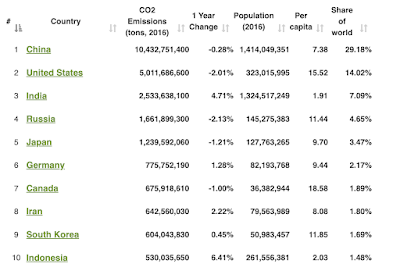
The three greatest threats we face today seem almost insurmountable. They include global climate change, whose consequences are potentially catastrophic for the whole planet, from Bangladesh to California and Florida; the rise of anti-democratic right-wing extremism in the United States and other liberal democracies, whose consequences threaten the viability of liberal democracy; and the resurgence of aggressive war.
Further, these threats are interconnected. Climate change will produce vast numbers of "climate refugees" and will deepen international conflicts over water and agriculture. Economic insecurity has the potential for worsening the trend toward right-wing extremism. Illiberal dictatorships are less constrained against the use force against their neighbors, and they are less likely to extend assistance to other countries in times when they are subject to powerful aggression by other dictators. And conservative ideologies have shown themselves to be indifferent to sober scientific studies of the dynamics of climate change. Climate scepticism is part of the canon for the far right.
Each of these challenges involves horrendously difficult problems of mobilization and coordination. Addressing climate change is perhaps the most difficult because of its global scope and long time duration. The root cause of global warming is the rapid rise of atmospheric CO2 and other greenhouse gases, largely the result of burning fossil fuels, along with massive deforestation (reducing the earth's capacity to remove CO2 from the atmosphere).

As the graphs indicate, CO2 concentration and rainforest depletion have increased exponentially since 1800, the beginning of the industrial age. But for many poor and middle-income countries, the urgent problems of poverty and low standard-of-living for much of their population demand solutions, and expansion of industrialization, manufacturing, and transportation all require growth in carbon production. ("Require" is probably too strong a word here, since we know that there are alternative low-emission energy sources; but those sources involve higher costs of infrastructure and operations.) So poor countries are unlikely to successfully support commitments to genuine carbon reduction. Further, about 50% of CO2 emissions are created by three countries, China, the United States, and India (link):

If these three countries fail to substantially reduce their CO2 emissions by 2060, it is hard to see how global goals can be met in time to avoid climate disaster. In the United States, there is an astounding level of resistance by the conservative right to the goal of reducing CO2 emissions (link). Here is the European Union plan for carbon neutrality by 2050 (link), and here are reviews of China's commitments (link) and India's commitments (link) to containment of carbon emissions.
What about the second challenge, the rise of right-wing extremist and nationalist political movements that explicitly threaten democratic institutions? Here the problem is twofold. First, rightwing Republican majorities in Red states have already succeeded in gerrymandering their populations in such a way as to make their electoral majorities essentially immune from future threats; and second, there is a well-orchestrated mobilization of rightwing extremist ideologies among a significant percentage of the public that has made "true believers" of these anti-democratic advocates. Therefore the political challenge of winning back a durable majority of the population in support of democratic institutions and a legislative and political agenda that enhances freedom and wellbeing of the whole population is difficult from the start. The politics of conspiracy theories, lies, and aggressive resistance to government action have created a high level of resistance to democratic change on the part of large portions of the US electorate. At the moment the organized politics of authoritarianism seem to have the advantage (link).
Finally, war. Vladimir Putin made it evident in 2014 that he was an opportunistic power-seeking autocrat, through his invasion and annexation of Crimea. His aggressive and atrocious war against Ukraine since February simply demonstrates how far he -- and the Russian state that he commands -- is willing to go to impose his will on his neighbors. Along with the courage and tenacity of the Ukrainian people, it is the surprisingly strong political will of the NATO alliance in supporting Ukraine that has frustrated Putin's war aims to date. Imagine the world situation if Donald Trump had succeeded in gutting NATO during his presidency. Trump, Orban, and other right-wing rulers have shown that they are only too willing to see the world through Putin's eyes. And that leads to a very worrisome implication: if the extremist GOP wins majorities in the Congress in 2022 and 2024, and possibly wins the presidency in 2024, then the United States could no longer be regarded as a staunch opponent and ally against the aggression of countries like Russia against their neighbors.
We have our tasks in front of us. Most immediately, we must prevail in defending the institutions of our liberal democracy, we must support the US government in establishment of effective climate change goals, and we must understand that military aggression must be confronted effectively, swiftly, and with courage. These tasks begin with electoral politics. We need a Democratic Party that can formulate and articulate an agenda that can inspire voters of every stripe, and we need candidates who can communicate our values effectively and show the mendacity of their Republican opponents. We need a presidential candidate with the brains and values of an Elizabeth Warren, the quick wit of a Jon Stewart, and the courage of an Abraham Lincoln.
